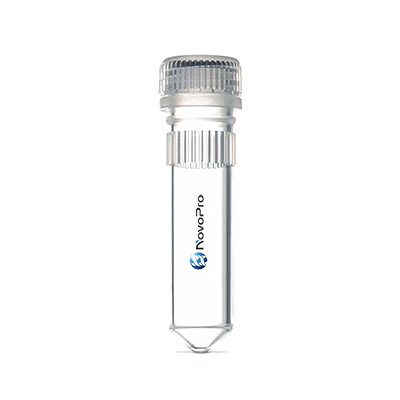产品详情
-
产品名称
IGF-1bsn 多肽
-
序列
Nap-FFGGYGSSSRRAPQT
-
三字母序列
1-Nap-Phe-Phe-Gly-Gly-Tyr-Gly-Ser-Ser-Ser-Arg-Arg-Ala-Pro-Gln-Thr-OH
-
长度 (aa)
15
-
多肽纯度 (HPLC, %)
95.45
-
分子式
C83H112N22O23
-
分子量(Da)
1785.91
-
来源
固相合成
-
描述
The peptide IGF-1bsn (Insulin-like growth factor-1 bioactive supramolecular nanofiber) is a novel biomaterial. It is obtained by covalently linking dodecapeptides (GYGSSSRRAPQT), which are a key binding site of IGF-1 receptor (IGF-1R) and play an important role in regulating IGF-1 activity, to an assembly peptide, Nap-FFG. IGF-1bsn has the potential to self-assemble and can form an opaque hydrogel by the heating-cooling process in PBS buffer (pH 7.4) at a concentration of 1 mmol/L.
The microstructure of IGF-1bsn is a three-dimensional network composed of nanofibers with a diameter of approximately 20 nm, and Fourier transform infrared spectroscopy shows the characteristic peaks of an amide I band at 1638 cm⁻¹ and an amide III absorption band at approximately 1232 cm⁻¹, corresponding to hydrogen-bonded β-sheet secondary structures.
IGF-1bsn exhibits good stability under physiological conditions and has weak frequency dependence, with the storage modulus (G′) being approximately an order of magnitude higher than the loss modulus (G″). In vitro degradation shows that IGF-1bsn remains above 26% after 24 h.
In rabbit BMSCs experiments, IGF-1bsn promotes BMSC proliferation in a mild and slow manner, enhances the migration of BMSCs at a concentration of 200 nM in vitro, and inhibits BMSC apoptosis. The optimal range to promote cell proliferation and migration, and to inhibit cell apoptosis is 100-200 nM, and 100 times of this concentration (10 μM) is used in subsequent in vivo experiments.
In summary, IGF-1bsn has good stability, biological activity, and the potential to enhance the activity of BMSCs, playing a role in osteogenic / chondrogenic differentiation of BMSCs to improve osteochondral healing and gap space integration after AOT mosaicplasty. -
储存指南
一般情况下, IGF-1bsn 多肽 粉末应该保存在-20甚至-70摄氏度. IGF-1bsn 多肽 溶解后应该-70摄氏度分装保存,避免反复冻融. 了解更多细节,请查阅手册:多肽溶解及保存指南
-
参考文献
- Wu H, Shang Y, Sun W, Ouyang X, Zhou W, Lu J, Yang S, Wei W, Yao X, Wang X, Zhang X, Chen Y, He Q, Yang Z, Ouyang H. Seamless and early gap healing of osteochondral defects by autologous mosaicplasty combined with bioactive supramolecular nanofiber-enabled gelatin methacryloyl (BSN-GelMA) hydrogel. Bioact Mater. 2022 Apr 5;19:88-102. doi: 10.1016/j.bioactmat.2022.03.038. PMID: 35441114; PMCID: PMC9005961.
-
关于三氟乙酸盐
三氟乙酸(Trifluoroacetic acid,简称 TFA)是高效液相色谱(简称 HPLC)纯化过程中常用的反离子。TFA 的存在可能会对肽的净重量、外观及溶解度产生影响,具体如下:
对净重量的影响:TFA 盐会增加产物的总质量。在大多数情况下,肽的含量占总重量的 80% 以上,剩余部分则为 TFA。
对溶解度的影响:TFA 盐通常能提高肽在水溶液中的溶解度。
在生物检测中的影响:对于大多数标准的体外检测,残留的 TFA 水平一般不会造成干扰。但需注意,在高灵敏度的细胞研究或生化研究中,需关注其存在可能带来的影响。
-
关于多肽净含量
干品多肽的重量中不仅仅包含多肽,还包含有一些非肽的组份,如水、被吸收的溶剂、配位离子和盐等。肽的净含量是指肽在其中的重量百分比,这个百分比的数值范围很大,可能从50%到90%,取决于纯度、序列以及合成和纯化的方法,不要将肽的净含量和肽的纯度混为一谈,他们是两个完全不同的概念。纯度通常是通过HPLC测定的。纯度定义的是多肽样品中含正确序列的组分的百分比,而肽的净含量是指样品中肽类物质相对于总物质所占的百分比,肽的净含量通常是氨基酸组分分析或紫外分光法测定的,这个信息主要是在一些对肽的浓度很敏感的实验中,对计算肽的浓度是很重要的。
-
摩尔浓度计算器
-
稀释计算器
-
百分比浓度计算器
质量 (g) = 浓度 (mol/L) × 体积 (L) × 分子量 (g/mol)
相关服务
多肽合成服务: 纽普生物(NovoPro)提供常规多肽合成、糖修饰多肽合成、稳定同位素标记的多肽合成、磷酸化多肽合成、荧光标记多肽、多肽的BSA/KLH/OVA等载体蛋白的偶联等服务。
